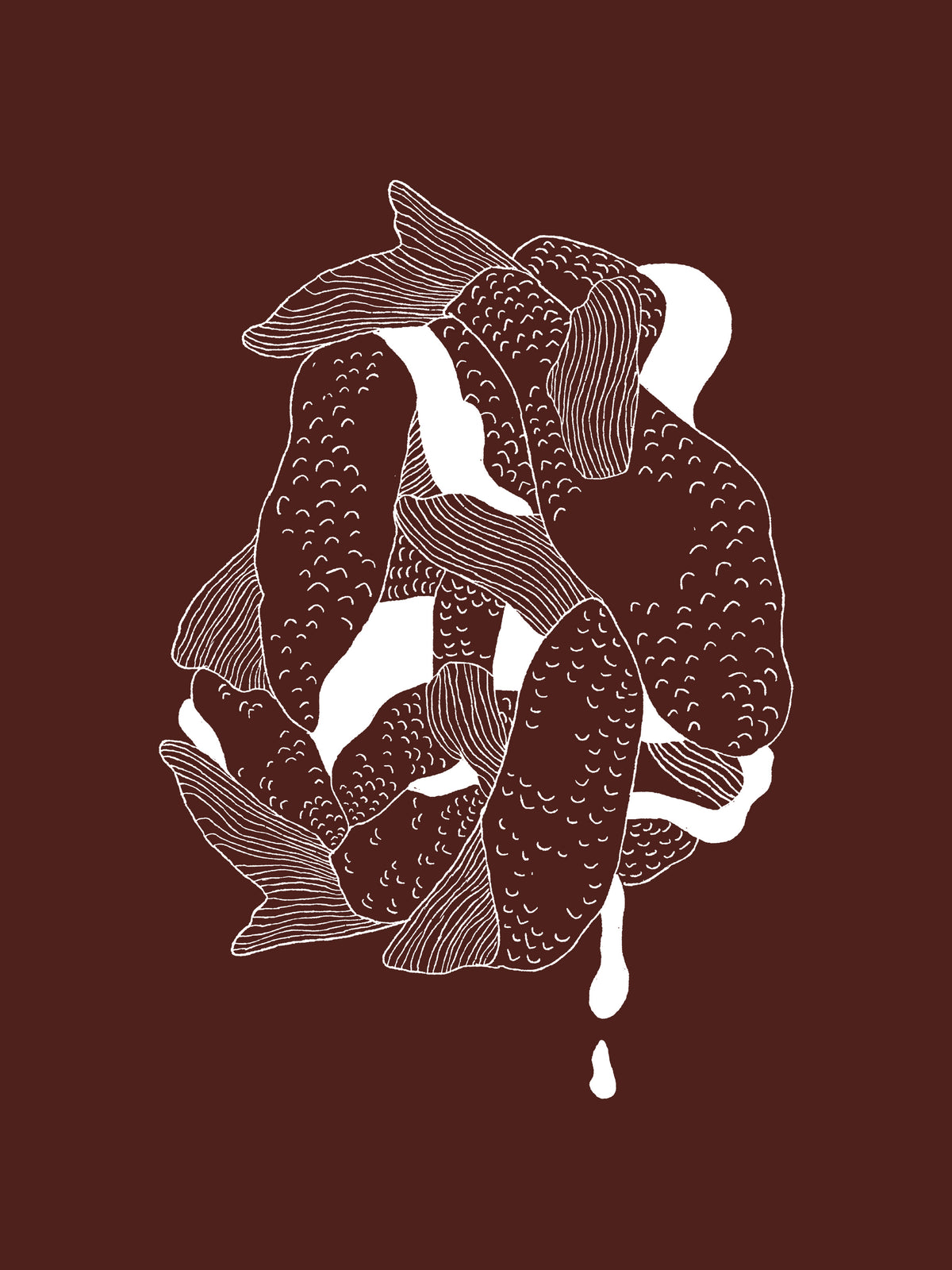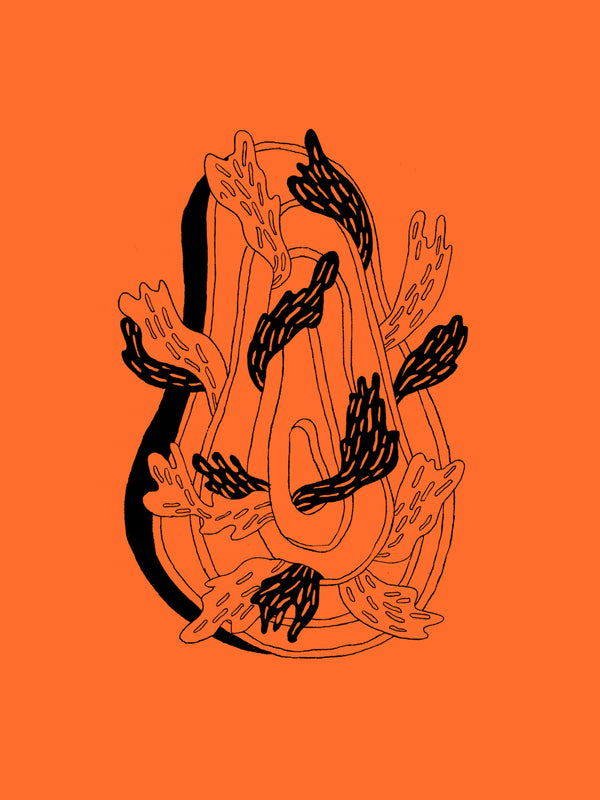Thomas Frebel, the former head of our test kitchen, was the first to suggest we try making garums with meat rather than fish. At the time, we’d been struggling with how we could make ancient traditions like garum feel new and distinctly ours. Thomas’s suggestion proved to be a brilliant one.
Garums are relatively easy to produce, and it turns out that the process works just as well with meat as it does with fish. We also found that if you add koji to the equation, you can reduce the time it takes to make garum by more than half. (Without the koji, many of the garums we make are technically not products of fermentation, but rather autolysis. More on this later.)
After a good amount of trial and error, we can say with confidence that the way that we make garum at Noma—fermenting animal protein in warm conditions with salt, water, and koji—is a novel twist on the traditional methodology. The resulting garums are quickly becoming among the handiest ingredients in our arsenal. They don’t play a starring role, but they’re there under the surface, imbuing dishes with an intangible magic, focusing and enlivening natural flavors. If you’ll forgive us for inventing words, they give things intricity, which is the portmanteau we’ve come up with to capture the intensity and electricity that ferments bring to cooking. There’s simply no other way we can think of to describe the effect of adding a teaspoon of squid garum to a big pot of steamed potatoes tossed with melted butter and a fistful of chopped parsley. The flavors come to a point—they have depth and umami, and taste like enhanced versions of themselves.
The most exciting thing is that we’re only beginning to understand the potential of garums. Rather than reaching for a pinch of salt in a recipe, we’ll sometimes kill two birds with one stone by using garum to bring both salinity and umami. And at a restaurant like Noma, where meat doesn’t play a huge role in the menu for most of the year, garums can give you the satisfaction of having eaten a piece of beef or chicken without the heaviness. When we do serve meat, we’ll often use a corresponding garum to up the intensity, whether that means a few drops of beef garum on strips of raw beef, or squid garum to enhance pieces of squid cured between sheets of kelp.
In a way, garums have allowed us to reverse the role of animals and vegetables at Noma, so meat becomes the seasoning and vegetables are the stars. A splash of garum can elevate an unassuming cabbage leaf to a satisfying and memorable bite. It’s really how we should all be eating, anyway. Before meat was a commodity, it was a luxury. When you could get your hands on it, you had to make it last. The earliest Chinese jiangs were mixtures of meat, soybeans, and Aspergillus, and they occupied a similar place as garums in the local cuisine. And in Scandinavia, people have been curing herring for centuries, and using the liquid runoff as a seasoning. They didn’t call it “garum,” but they recognized its usefulness. It’s all about stretching the resources you’ve got—a practice that often leads to delicious innovations.
Carthaginian Fish Sauce
Garum’s story begins in North Africa 2,500 years ago, when the walled Phoenician metropolis of Carthage was a booming port in what is present-day Tunisia. Within the city walls, surpluses of fish harvested from the flourishing waters of the Mediterranean Sea—tuna, mackerel, anchovies, sardines—were sliced finely, scales, heads, guts, and all, then layered with salt in limestone vats and left to ferment. Nets draped over the vats would keep larger animals and flies out. The heat of the sun would effectively cook the fish, while the salinity would act as a safeguard against the propagation of harmful microbes. Most important, the guts of the fish contained enzymes that fueled the transformation from vat of fish parts to potent seasoning.

Ancient Carthaginian garum factories were carved out of limestone in ports along the Mediterranean Sea.
The Carthaginians enjoyed a reign over the Mediterranean for close to five hundred years, until the city fell to the Roman Empire in the Second Punic Wars. To the victor go the spoils, and as Carthage changed hands, so did its culinary practices. Though the product originated in North Africa, the Romans are the ones credited with the dissemination of garum—a Latin word derived from the name of a specific fish species. Sicily, with its proximity to Carthage, was likely where the gospel of fish sauce first spread, and it served as the center of garum production in the ancient Roman Empire.
In much the same way that nuoc mam is used in Vietnamese cuisine as both a dipping sauce and a seasoning, garums would have been served at the table but also kept in the kitchen to be used with wine as a cooking sauce called oenogarum. Garums served the Roman army well, too. Soldiers could carry the concentrated salty liquid in a flask and dilute it while in the field. After the Third Punic Wars and the Roman annexation of Iberia, garums spread west. In southern Spain, ruins of garum factories carved out of limestone are still standing to this day.
As garum grew, specialized classifications emerged. The sediment left over after straining a batch of garum was known as allec. It was deemed undesirable by elites and left to the commoners. Muria was garum made from fish that were gutted and had their heads removed, which would have rendered the finished sauce less pungent. Haimation, a fermented product that consisted of nothing but the guts and blood of fish, was made from the by-products of fisheries. Its dark color also led it to be dubbed “black garum.” Liquamen was once a term distinct from garum, as it was used concurrently in early Roman times, though it isn’t entirely clear what the difference was. Some believe it to be a second steeping of the allec in an attempt to extract more yield from the fermented fish. Others explain it as garum made specifically with whole fish, whereas garum is an umbrella term for the larger family of related sauces.
What’s even less clear is why garum fell out of fashion in the West. The last vestige of garum in Europe is a rare Italian sauce called colatura di alici, traditionally made in the small fishing village of Cetara. Its recipe was recovered by monks in the Middle Ages from much older Roman texts. Meanwhile, fish sauce remains a bedrock of Southeast Asian cuisine and an ingredient that many of us are far more familiar with. The process of making it is remarkably similar. Anchovies fished from the Gulf of Thailand are placed into large wooden vats, layered with salt in a ratio of two or three parts fish to one part salt. The salted fish are pressed beneath a bamboo mat weighted down with rocks and left in the tropical sun for 9 to 12 months, before being pressed and strained for their juices. Most of the fish sauce you’ve tasted in your life is made this way.
The curious thing about Asian fish sauces is that there aren’t many references to them in historical documents from the region before the seventh century. Cultural exchange between the Roman Empire and Asia was established long before then. Given garum’s value to ancient Romans and its portability, it’s tempting to draw a connection between Thai fish sauce and garum, as opposed to assuming both products were developed independently. It’s fun to imagine a direct line between the vastly disparate cooking styles of Southeast Asia and the Mediterranean, but we’ll leave that for more qualified parties to decide.
Fish Digesting Fish
The fact that fish sauce stinks is nothing new to anyone who’s ever cooked with it. But fish sauce doesn’t actually smell fishy—at least, not if it’s made well. Fishiness is a result of fish flesh and fats being spoiled by bacteria. If the fish in a garum isn’t fresh, the finished garum will suffer for it. Fish innards— the main catalysts responsible for making garum—have a pungency that’s quite different, earthier and less offensive than rotting fish.
The traditional method of making garum combines wild fermentation with autolysis. An autolytic process is one in which an organism’s tissue or cells are broken down by enzymes produced by the organism itself. In other words, to make garum, you turn an animal’s normal digestive process on itself.

Autolysis is the term used to describe an organism digesting itself.
The flesh of all animals contains proteolytic (protein-dismantling) enzymes that contribute to autolysis. If you’re wondering why you’re not digesting yourself right now, it’s because those enzymes are present in extremely small quantities, and in an organism’s healthy cells, they are sequestered within an organelle known as a lysosome. But once an animal dies, its enzymes act upon its flesh indiscriminately. Take dry-aged meat, for example: When a cut of beef is left on a shelf in the fridge, the enzymes it contains will slowly break down its connective tissue and muscle, tenderizing the meat and making it more delicious as the proteins are snipped into their constituent amino acids.
Making garum is essentially the same thing as dry-aging beef, only wetter, faster, and more intense. Rather than harnessing the enzymes in an animal’s flesh, garums depend on the enzymes in the gastrointestinal tract, which are even more concentrated and potent. An essential part of making garums the traditional way is to chop up the whole fish—guts, flesh, and all. As the fish sits in vats with salt, the digestive juices (both stomach acids and intestinal enzymes alike) come into contact with the flesh of the fish they’re normally kept separate from. The juices go to work on the fish flesh, breaking down proteins into their constituent amino acids, and fats into fatty acids. The salt does double duty, expediting autolysis while simultaneously safeguarding the mixture against harmful microbes. That said, there are a handful of halotolerant (salt-tolerant) microbes that live in a mash of saline fish, adding to the garum’s bouquet of volatile aromas in much the same way that shoyu’s community of beneficial microbes does.
Enzymes need to be suspended in a liquid medium to function efficiently; otherwise they won’t be able to float from one protein chain to another, snipping them into amino acids as they go. Salt draws moisture out of the fish into its surrounding environment through osmosis, creating a soupy environment for enzymes to travel through. As the fish’s muscles break down, the salt has an even easier time drawing out more water. The process snowballs, liquefying solid fish into garum. (Heat also precipitates enzymatic reactions, which explains why garums were traditionally fermented under the hot Mediterranean sun. Temperatures hovered around 30°C/86°F in the summer in ancient Carthage; a garum would near completion in 6 to 9 months in that kind of heat.)
Salt / Water
Salt’s other role in a vat of garum is to prevent spoilage. As mentioned many times in this book, there are plenty of halotolerant spoilage bacteria that have no problem living in mildly saline environments. But there is a limit, and garum’s salinity sits over that limit. Highly salted solutions safeguard against spoilage via two mechanisms—osmosis, which you’ve already read about, and another property called water activity, which extends to all types of fermentation.

When surrounded by a salt solution, the water in cells travels outward to areas of higher ionic concentration. As a result, the cell shrivels and dies.
Water activity is not a measure of how much water is within a product, but rather how tightly bound the water is to that product. It’s a measure of how much water vapor a sample gives off, expressed as a ratio. Distilled water has a water activity of 1, while a totally dry substance—for instance, sand that’s been baked in an oven so that any water inside it has evaporated—has a water activity of 0. Dried fruit has a water activity of about 0.6; raw meat, about 0.99. Most bacteria need an environment with a water activity above 0.9 to grow; fungi, above 0.7. (Freezing, by way of locking water molecules into a rigid lattice, also effectively lowers water activity, and is the reason it’s such an effective method of preservation.)
In a batch of garum, salt lowers the water activity of a mixture by binding to individual water molecules, effectively removing them from the solution. Because the water molecules are sequestered by salt ions, they are unavailable to the microbe’s normal life processes. This works in concert with osmosis, which acts the same way on microbial cells as it does on meat or fish. The salt draws water out of the microbe’s cells, collapsing them so they shrivel and die. This mechanism staves off spoilage in all sufficiently salted products, not just in garums, but also aged cheeses, cured meats, misos, shoyus, and lactic ferments.
Better Living Through Koji
The flavor molecule most responsible for garum’s deliciousness is glutamic acid. Glutamic acid is an amino acid that is present in almost all proteins. In its free form (just hanging out, not part of a protein chain), it can be found in especially high concentrations in meats, cheeses, tomatoes, seaweed, and wheat. When the proteolytic enzymes in a vat of garum cleave apart the proteins in fish or meat, it frees molecules of glutamic acid, which then give up a free positive charge to become glutamate. Glutamate, in turn, binds to mineral ions like sodium to form monosodium glutamate (MSG).
Aside from being a well-known powdered food additive, MSG is naturally responsible for some of the world’s most delicious foods, from ramen to risotto. It registers on the tongue not as a flavor, per se, but as the sensation of umami—the “fifth element” of taste, often thought of as the essence of savoriness, first postulated in the early 1900s by the Japanese chemist Kikunae Ikeda. Perhaps the best descriptor of its flavor is “moreish”—as in, when you taste it, you want more. Glutamates can even evoke the physiological reaction of salivation, literally making your mouth water.
We’re primed for umami from birth—human breast milk contains ten times as much free glutamate as cow’s milk. During breastfeeding, the glutamate content in milk rises steadily as infants nurse, to the point where it can account for as much as 50 percent of the total free amino acids. We even have glutamate receptors in our gut that signal our brains as we begin eating something rich in umami: Our appetite immediately increases, but we feel sated sooner and for longer than when we eat a low-umami meal. We’re hardwired to find umami satisfying, and we seek it out as a result.
While the most pronounced feature of garums and fish sauces is the powerful funk generated by autolysis and fermentation, the smell is actually misleading. The stinkiness is something you come to appreciate, but the glutamates are the foundation of garum’s appeal, elevating all that they touch. Now, say you wanted to mitigate garum’s aroma while maintaining its complexity and glutamic content. You could omit the guts responsible for autolysis, but you’d need some other tool to break down protein into amino acids. And in koji, once again, we find a friend.
Koji produces enzymes called proteases, which we use at Noma to break down the proteins in beef, squid, mackerel, clams, and other protein sources. Put simply, koji steps in and does the job of the digestive enzymes in the guts of fish, yielding a finished product with as much umami as the traditional method, but a far more pleasant smell.
In order to produce a faster garum, we also ferment ours in a room held at 60°C/140°F. While this temperature precludes microbial activity, it accelerates enzymatic activity to a maximum while simultaneously facilitating Maillard reactions that imbue the sauce with the flavor of roasted meat. At this temperature, we can typically go from a bucket of meat to fully finished garum in 10 to 12 weeks. You’ll notice distinctive changes in the product as those weeks go by. At first, it tastes like a murky stock, but after the first week or so, the enzymatic action takes off and you can sense the umami building. After about a month, more caramelized flavors step to the front. By the end, everything sits in delicious harmony.
It’s possible that you find something inherently worrisome about placing raw flesh into salt water with moldy grains and letting them sit for months, but rest assured, garums are by far the most precise and safe ferments we make at Noma. The high salt content (about 12% by weight), coupled with the high temperature, creates an environment that nearly all food-borne pathogens can’t tolerate.
Meanwhile, we’re continually trying to dissect garum and rebuild it in different ways. We’ve experimented with a variation that omits water, and ended up with a much thicker mixture that resembles Thai shrimp paste. We’ve made garums with protein-rich plant matter, like peas, that work well but shouldn’t be left in the heat for as long as animal protein. We’ve also tried garums with more unconventional sources of protein, like bee pollen, grasshoppers, moth larvae, and pig’s blood. There’s plenty more to explore in this vein. For the adventurous spirits out there, take a look at pineapple and papaya. They’re both fruits heavy with proteolytic enzymes, and you might be able to conjure up a tropical garum. We don’t get many pineapples here in Denmark, but it’s an idea.

Glutamate (C₅H₈NO₄) is the delicious taste of umami in molecular form.
—
To keep reading: Order your copy of the The Noma Guide to Fermentation today.





















































